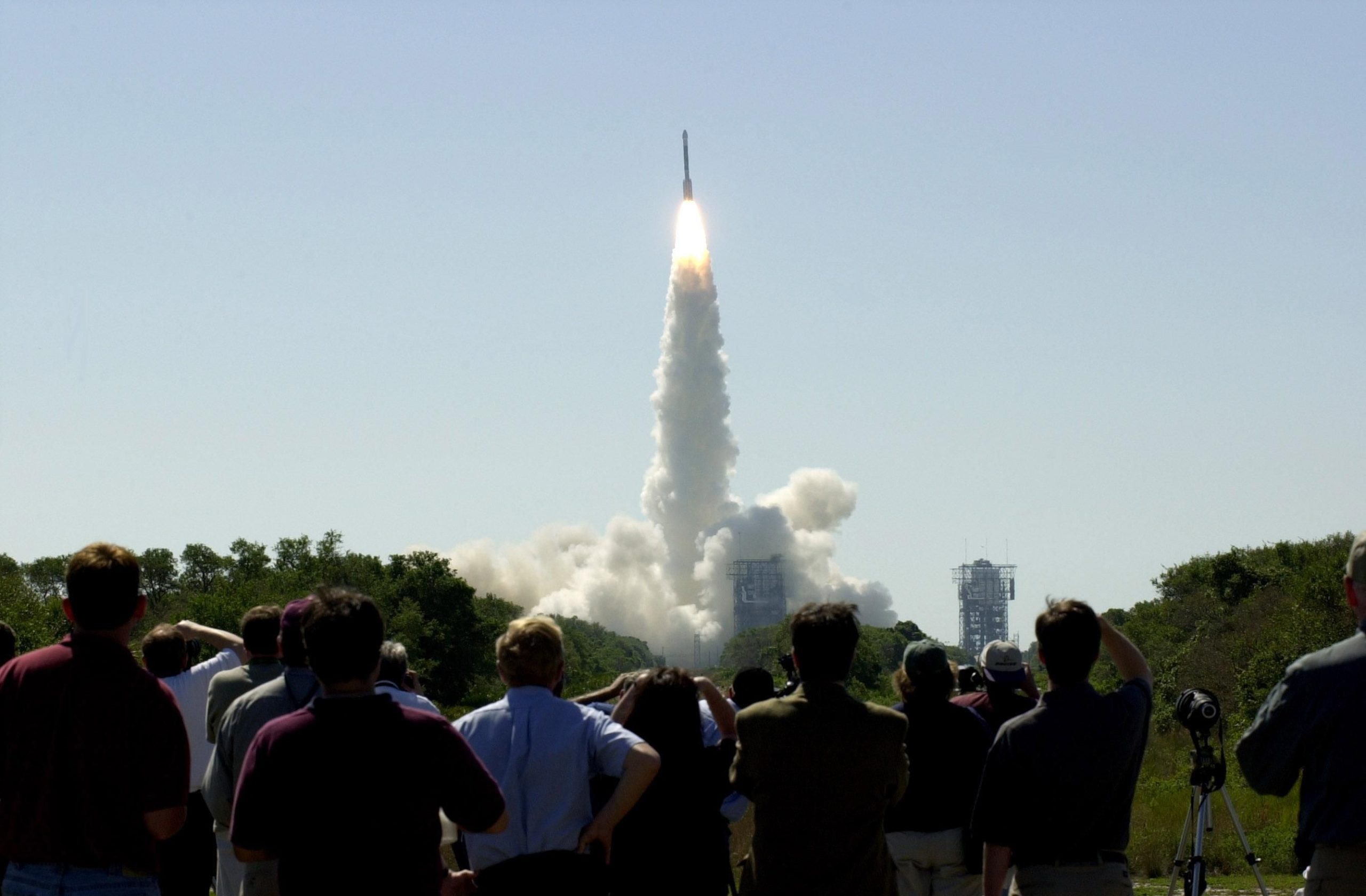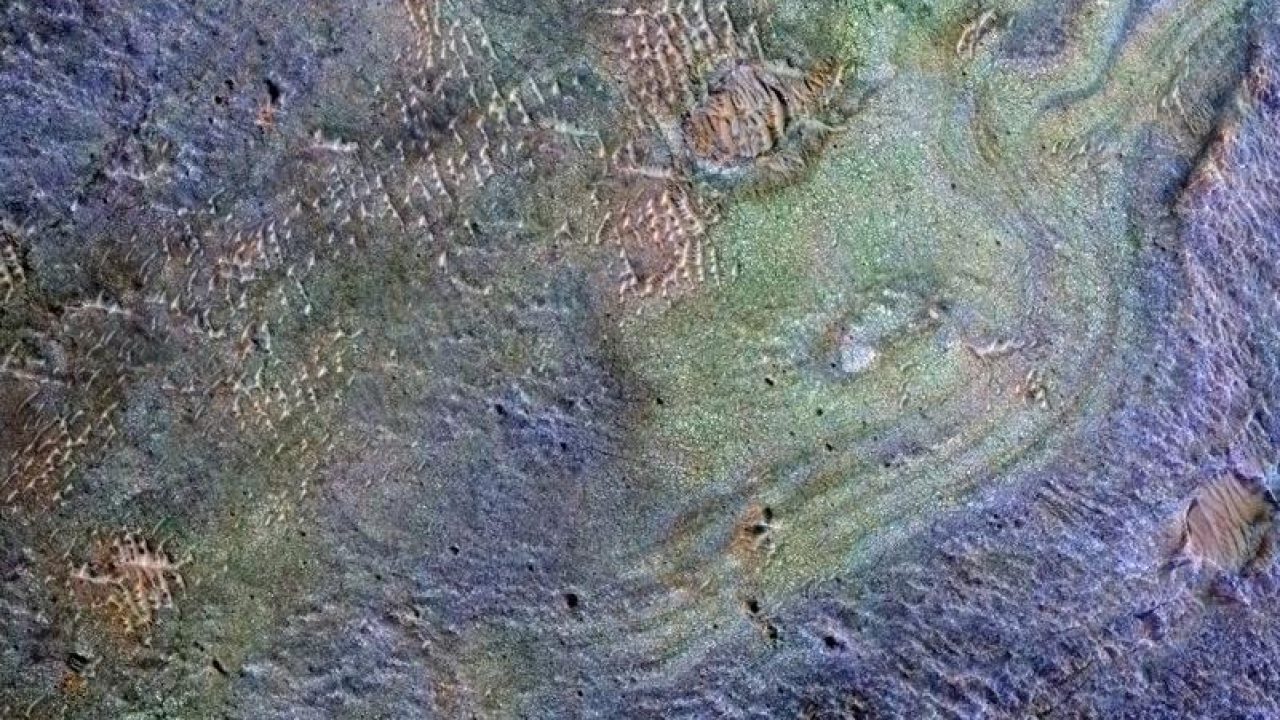How did it all start?
An orbital vehicle that takes its name from the classical
 April 7, 2001, 11:02 am.People watch the launch of a Boeing Delta II rocket powered by NASA's Mars Odyssey spacecraft from a station at Cape Canaveral, Florida. The spacecraft's journey to Mars will last seven months / © NASA
April 7, 2001, 11:02 am.People watch the launch of a Boeing Delta II rocket powered by NASA's Mars Odyssey spacecraft from a station at Cape Canaveral, Florida. The spacecraft's journey to Mars will last seven months / © NASA
But he did so much more by discovering the depositswater ice, it also served as an important communication channel for other spaceships and helped pave the way not only for safer landing of rovers, but also for future astronauts.
Here is a partial list of Odyssey's many accomplishments.
Martian ice mapping
Data collected over two decades of Odyssey,helped scientists understand where water ice is on the planet. Mars was once much wetter than it is now, just like Earth. The very understanding of the water cycle on Mars gives astronomers an idea of how it has changed over time and what is happening to it today. Does the tilt of the planet affect where the ice is stable? Odyssey's discoveries helped address these issues.
“Before Odyssey, we didn’t know where all thethis water was stored on the planet, explains project scientist Jeffrey Plaut of NASA's Jet Propulsion Laboratory in Southern California, which is leading the Odyssey mission. “We first discovered ice from orbit, and later confirmed its location with the help of the Phoenix lander.”
 Pictures taken by Odyssey THEMIS from 2002 to 2004 in a weathered field of dark dunes. NASA
Pictures taken by Odyssey THEMIS from 2002 to 2004 in a weathered field of dark dunes. NASA
In addition, water ice supplies are required tosurvival of astronauts on Mars. In fact, future explorers and colonizers of Mars were the focus of the instrument aboard the Odyssey. He also measured how much cosmic radiation they would have to contend with. The orbiter finds water ice using its gamma-ray spectrometer (GRS) detector. The device measures the amount of various elements on the surface of Mars and also serves as a node in NASA's interplanetary gamma-ray burst (GRB) detection network. The system determines the location of the sources of gamma-ray bursts for subsequent astronomical observations.
 Photo: NASA / JPL-Caltech / University of Arizona
Photo: NASA / JPL-Caltech / University of Arizona
What is Mars made of?
Look at almost any cartographicexploration of the surface of Mars. It most likely includes Odyssey data. For many years, the most complete global maps of Mars have been made with its infrared camera, the Thermal Emission Imaging System, or THEMIS. It measures surface temperature day and night. This helps scientists determine where rock, sand, or dust is on the planet. His data show the presence of these materials depending on how they heat up or cool down during a Martian day.
 Plain of Nili Fossae in the north of Mars. A deposit rich in carbonates. NASA
Plain of Nili Fossae in the north of Mars. A deposit rich in carbonates. NASA
Scientists have not only used the data toMapping networks of valleys and craters, they also discovered sandstone, iron-rich rocks, salts and much more on the surface of Mars. All this allows us to better understand the history of the planet. “It’s hard to overstate how the THEMIS global map has filled gaps in our knowledge,” said JPL’s Laura Kerber, Odyssey’s deputy project scientist.
 The Mariner Valley is a giant canyon system on Mars. The image is composed of over 500 daytime shots from the Odyssey camera. NASA
The Mariner Valley is a giant canyon system on Mars. The image is composed of over 500 daytime shots from the Odyssey camera. NASA
Safer landings
THEMIS has sent over 1 million images sincesince it started circling over Mars. The generated images and maps allow you to understand the topographic features of the planet and the boulders on it. It helps the Martian scientific community and NASA decide where to send lander and rover, including the Perseverance rover, which landed on February 18, 2021. In addition, it provides safety for future astronauts by showing the location of resources such as water ice.

Home connection
From the very beginning, the Odyssey mission served as the centercommunications for NASA's rovers and landing devices, sending their data back to Earth as part of the Mars relay network. The very idea of a repeater dates back to the 1970s, when two Viking lander sent scientific data and images back to Earth via an orbiter. The orbiter's design includes antennas capable of transmitting more data than a ground-based spacecraft. Odyssey made the transmission from Mars a chore when it began transmitting data to and from the Spirit and Opportunity rovers.
“When the two rovers landed, the success of UHF data transmission was a game changer,” emphasizes JPL's Chris Potts, Odyssey Mission Leader.
 NASA's Mars Odyssey spacecraft passes over the south pole of Mars. Conceptual art illustration. NASA
NASA's Mars Odyssey spacecraft passes over the south pole of Mars. Conceptual art illustration. NASA
Every day the rovers could go to a newplace and transmit fresh images to Earth. With a repeater like Odyssey, scientists get more data quickly and the public gets more images of Mars. Odyssey supported over 18,000 relay sessions in total. Today, it shares the task of communicating with NASA's Mars Reconnaissance Orbiter and MAVEN, as well as the Trace Gas Orbiter from ESA (European Space Agency).
Candy colored moons
Odyssey has done such a thorough job ofthe study of the surface of Mars that scientists began to use the THEMIS camera to capture the unique views of the satellites of Mars - Phobos and Deimos. As with the surface of Mars, studying the thermophysics of each moon helps scientists determine the properties of materials on their surface. Such information can provide insight into their past. It is not yet clear whether the satellites are asteroids captured by the planet's gravity or pieces of Mars that were separated from the surface as a result of an impact in the distant past.
 Six images of the Martian moon Phobos by THEMIS by March 2020. NASA
Six images of the Martian moon Phobos by THEMIS by March 2020. NASA
Future missions like spaceshipMartian Moons eXploration (MMX) of the Japan Space Agency (JAXA) are planning to land on these moons. In the distant future, missions may even create bases for astronauts on them. And if they do, they will rely on data from the orbiter that began its Odyssey at the beginning of the second millennium.
THEMIS was built and operated by the universityArizona State. The Odyssey gamma spectrometer is provided by the University of Arizona at Tucson, Los Alamos National Laboratory and the Russian Space Research Institute. The main contractor for the Odyssey project, Lockheed Martin Space in Denver, designed and built the orbiter. Mission operations are jointly conducted by Lockheed Martin and JPL, a division of the California Institute of Technology in Pasadena.
Read more
The first accurate map of the world was created. What's wrong with everyone else?
NASA told how they will deliver samples of Mars to Earth
Scientists explain the appearance of "spiders" on the surface of Mars